Millions of Americans live without reliable internet services. For farmers and food providers, this leaves them lagging behind competition and stuck with outdated equipment. Now, they’re looking to the Farm Bill for answers.
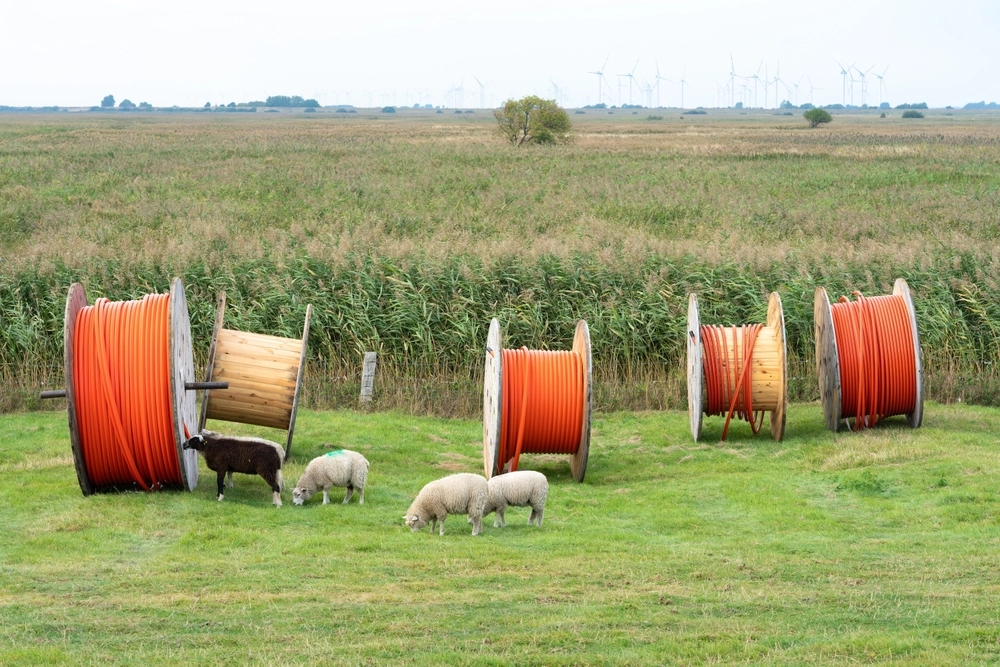
When COVID hit, Lisa Stroup was excited for her granddaughter to come stay with her full time. The girl’s father was deployed with the military and her mother is a front-line worker; it was safer and easier for everyone if the then-five-year-old moved in with her grandparents for a while.
But things got complicated, and quickly. As schools went virtual, little Hudson had to start her kindergarten classes online. “It was impossible. She could not connect, even with the hotspot device, because we get terrible reception. Nothing worked,” Stroup recalls. By the third day of school, the girl was crying, worried that the rest of her classmates would learn to read while she was left behind.
Stroup closed the laptop. She packed a lunch, took her granddaughter by the hand and walked down to the nearby creek. Together, the pair went through sets of picture books, until Hudson was able to sound out the words by herself.
Unfortunately, most issues caused by Stroup’s slow internet connection are not so easily solved. Stroup and her husband farm about 200 acres near Bessemer City, NC. They raise beef cattle and plant wheat and soybeans. But they have been consistently stymied when it comes to internet access on their farm. The issue became even more apparent during COVID. With no reliable internet connection, the Stroups were stuck selling person to person, in a time when that sort of business was the most dangerous option. “It crippled us, especially then,” says Stroup.
Even now, the lack of internet keeps the farm lagging behind. Most new farming equipment relies on an internet connection for GPS or other services. Even if the machine itself is not connected, you need the internet to fix it. “If you buy something new, they no longer give you a printed manual. As far as fixes and repairs and whatnot, you have to be able to download [a manual] off the internet.” So, Stroup is stuck with vehicles and equipment from the 1970s. “We can’t modernize,” she says. “We’re cut off.”
The Stroup farm is a classic example of those impacted by the middle mile effect. In an urban area, if an internet service provider (ISP) lays a mile of cable for broadband internet, it will be able to connect hundreds, if not thousands, of customers because the area is densely populated. In a rural area, that same mile of cable might connect a single family, so ISPs aren’t financially incentivized to run cable in those regions. What ends up happening is a lot of high-volume areas, surrounded by dead zones.
In fact, Stroup says she was told by one ISP that it would not run cable connecting her farm with a new housing development being built at the edge of her property line unless the Stroups paid for it themselves at a cost of more than $15,000. Stroup was shocked. “Are you crazy?” she thought. “Why am I paying for it?”
She sent a letter to her senator, who responded in 2021. He said there could be funding available for her through the Infrastructure Bill but that the decision of how and when to allocate those funds was down to the local level. He encouraged her to contact her governor. Stroup did. The governor’s response was to send her a fundraising letter.
“You hear on the news that there’s new funding available and billions of dollars pumped in to specifically connect the middle mile,” says Stroup. “Where is that funding?”

Lisa Stroup and her granddaughter. Photography by Lisa Stroup.
Mapping broadband’s dead zones
The Federal Communications Commission (FCC) defines broadband as having download speeds of at least 25 megabits per second (MBPS) and upload speeds of at least three MBPS. The commission is in charge of keeping track of who is connected, what their speeds are and what needs to be done to get more Americans connected. It collects data, which gets compiled into the National Broadband Map. But the numbers on how many people are without broadband are anything but concrete. Some government figures put it at one in five US households, which would be 24 million households without access. The FCC’s 2020 report estimated that there were only 21 million individuals without access. But research from BroadbandNow, an independent firm, puts that number closer to 42 million Americans.
The data is all over the place because the FCC’s mapping system is not verified. “They rely solely on information provided by ISPs,” says Sascha Meinrath, the Palmer Chair in telecommunications at Penn State University. “Every ISP is providing these hyperbolically rosy estimates of where they serve and the speeds that are available in those locations. And there’s no meaningful verification, much less any accountability.”
Meinrath says when you get down into the data, you find that the majority of people who aren’t connected to the internet are rural Americans and the poorest in the country. “Neither of those constituencies have a whole lot of wealth to squander,” he says. But that’s exactly what’s happening, as they often have to pay more for worse service. In the Cost of Connectivity report, researchers found that Americans pay more for internet services than most other countries in the global north, and the gap in service disproportionately affects people of color.
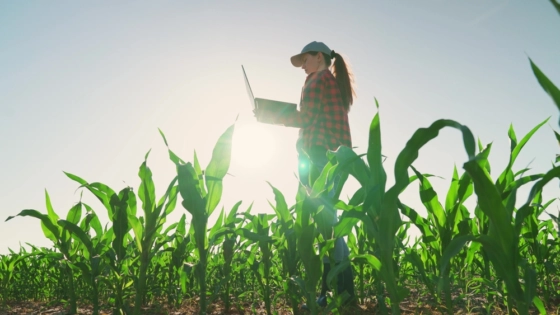
Photography by Shutterstock.
Meinrath says a big part of the problem is that our ISPs don’t interoperate, meaning they don’t use each other’s equipment or infrastructure. And we’ve been here before. Picture an old black and white movie. There’s often a big boss, and they’ve got many different phones all sitting on their desk, each using a different telephone system. However, in 1934, the Communications Act passed with the mandate of universal service: the idea that everyone has the right to access communications services. The phone companies were forced to work together, and folks were able to have a single telephone for all of their needs.
But now, says Meinrath, we’re right back where we started with ISPs. They don’t share infrastructure, which is why you’ll often see multiple cellular towers in the same area, because each provider uses their own. It’s expensive and goes against the proven success of a universal service mandate.
So, what could the Farm Bill do about this? There are a few areas that we could start with, and Meinrath says the first one won’t cost the government a dime. “The Farm Bill could include a mandate that says anytime a provider reports to a federal agency that they provide service at an address, they must provide that service within 30 days or get fined $10,000 a day until they do,” says Meinrath. In other words, force the ISPs to show verification that they are doing what they claim. “You would spend nothing, and all of your maps would get super accurate, super quickly.”
Beyond that, we could look to bring back the idea of common carriage. Up until 2005, we had common carriage in the US, just like the universal service with telephones. “If you had a telecommunications infrastructure, you had to carry the traffic of your competitors. For example, we all remember the dial-up modem days and all those CD-ROMs sent by AOL. The reason they could do that is because whoever your local phone provider was, they had to allow you to use their infrastructure,” says Meinrath. But the government got rid of common carriage in 2005, so ISPs started focusing on only the most profitable areas, leaving “nothing in other areas. And if you look, we have spent more on infrastructure than it would cost to provide universal service.”
In the face of evidence and data, why have we set up a system that overbuilds in urban areas and nearly ignores rural spots? “The honest answer is because we’re idiots,” Meinrath says facetiously. “The opportunity cost to the country is an order of magnitude greater than the cost of just funding the build… It doesn’t make sense to the populace, not just rural, but the entire populace. And the only reason why we’ve done that is we have allowed ISPs to really dictate our policy, even when it is a vast detriment to society.”
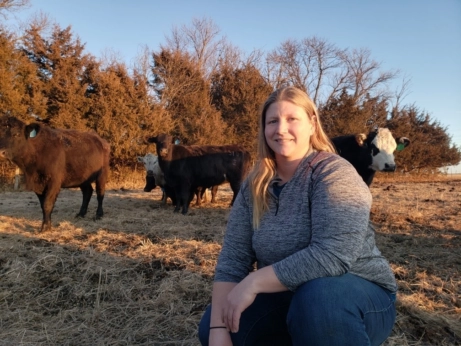
Emily Haxby on her farm. Photography courtesy of Emily Haxby.
Struggling to connect
Emily Haxby, a fifth-generation farmer in Gage County, NE, has been vocal about what the lack of internet means for her and her neighbors. Or at least, she’s tried.
“I was actually doing a Zoom call with the Farm Bureau, the state board, and we were talking about broadband and connecting people, and those 11,000 missing locations in our state. And I kept glitching out, because I didn’t have an internet hotspot.”
Haxby and her family farm corn and soybeans and raise cattle and goats. When folks outside of agriculture think about those tasks, they may not realize just how connected modern farmers need to be. But Haxby uses wifi-connected monitoring systems for her crops and animals, but needs to drive into town to upload her data. All of the pivots she irrigates with are monitored and connected to the internet. And without reliable broadband, things get pricey. “A lot of people are using cellular [data] because that’s all that’s available,” says Haxby.
While Haxby does have some internet service, the speeds are much slower than she needs. For instance, the camera that she keeps in the barn to watch over her animals isn’t the most reliable. “It’s very glitchy when I’m watching my critters. Have you ever seen a lagging goat walking around a barn? It’s really funny,” she says. On average, the speeds in Haxby’s area are about six MBPS to download and two MBPS to upload (far slower than the 25-three benchmark set by the FCC). Haxby says she’d like to install more cameras, especially in the calving season, but she can’t rely on them with her current connectivity.
So, she tried to do something about it. She ran for supervisor in Gage County, and was elected on a platform that focused on internet access. She headed the Gage County Rural Broadband Project, with the aim of getting fiber internet out to at least 40 percent of the region.
Now, after months of work, the project is moving forward with the ISP NextLink. Cables are going in the ground now and connecting more than 1,000 homes. “People are so excited to finally be connected with something more reliable. I get so many calls [asking] ‘when will it get to my place?’” says Haxby. The initial phase of the connection project will service about 40 percent of Gage County, but Haxby says that’s just not enough. Even with a goal of 99 percent of the state, that leaves out one percent of Nebraskans, or roughly 20,000 people.
Haxby hopes these figures will finally compel ISPs to build out in rural areas. “I think for a long time providers have gotten complacent. There hasn’t been a push to get fiber to rural areas. I know there’s a cost barrier to that, but as a nation, we’re starting to see this is important,” she says. She hopes the Farm Bill comes with stipulations on its funding. “I hope the Farm Bill includes, at bare minimum, a requirement that any funding of broadband should be a minimum of 100/100 for speeds. We need to do what we can to make sure that the money that is being expended isn’t immediately outdated as we progress into the future.”
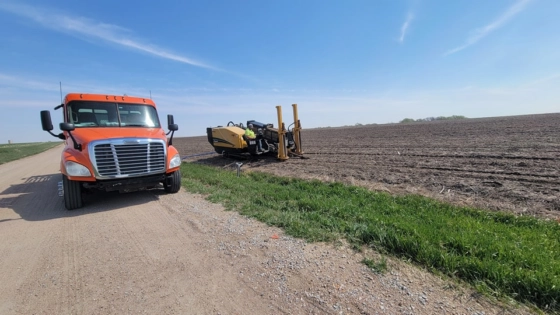
Broadband getting installed in Gage County. Photography by Emily Haxby.
Many legislators are promoting broadband. Georgia Senator Raphael Warnock and South Dakota Senator John Thune presented the bipartisan Promoting Precision Agriculture Act this spring, aiming to develop a national taskforce to determine connectivity standards for farm equipment. “Setting interconnectivity standards will help more agriculture devices, from a soil monitor in the ground to a drone overhead, talk to one another and transmit data efficiently, so that farmers can always have the latest information available to make decisions to improve efficiency, improve crop yields and lower costs,” a representative from Warnock’s office told Modern Farmer.
Senator Warnock, among other legislators, has also been vocal in pressuring the FCC to release broadband funding through the Rural Digital Opportunity Fund, and his representatives say he is working to include specific language relating to broadband internet and precision agriculture within the Farm Bill.
At the state level, many government agencies are instituting grant policies to try and effectively distribute federal funding for broadband. In Minnesota, officials from Governor Tim Walz’s office say their data shows that roughly 180,000 households in rural areas are without broadband. So, they are distributing $100 million over the next two years through two programs: the Border to Border Broadband Development Grant and the Low Density Grant. The goal is to have all Minnesota homes and businesses connected to high speed internet by 2026.
But that could be where the issues lie. It’s not that people aren’t invested in solving this problem. It’s that too many people in too many disparate agencies are working independently, says Emily Buckman, director of government affairs with the American Farm Bureau Federation. “We have been supportive of the ReConnect program, which has become the USDA premier broadband program over the last five years and the most funded,” says Buckman. “We also will be supportive of just streamlining the programs that are currently in place. There’s a rural broadband program over at USDA that’s pretty similar to ReConnect…There’s just so many programs out there that we would like to see as much streamlining as possible, so that it makes it easier for the providers to apply and get those networks deployed.”
Broadband has been a priority for the AFBF for years, says Buckman, but the conversation ramped up during COVID. It was then that the federation members recognized broadband access as a priority to push for within the Farm Bill. “Farmers and ranchers depend on broadband, just as they do highways, rails, waterways, to ship food and fuel across the country,” says Buckman. “We hear a lot about sustainability these days; our members are doing a lot more with less. And a lot of that is due to the technology advancements that have occurred over the last several decades. And many of those do require connection.”
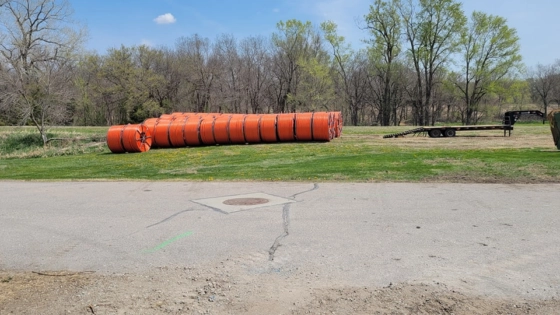
Broadband getting installed in Gage County. Photography by Emily Haxby.
Disconnecting
Lisa Stroup in Gaston County is doubtful that she’ll ever see high-speed internet on her property. It’s doubly frustrating, as she watches the new housing development at the end of her property get fully wired. “The people who could make it happen don’t respond to you. Nobody is familiar with [the issue]. I’m like, OK, so what do I do with that? Who do you call?”
Stoup eventually called her county office and was told they had no more funding to allocate to additional broadband, a fact that Justin Amos, the county manager’s chief of staff, confirmed. The county was able to participate in a grant program last year for the first time, partnering with the ISP Spectrum Southeast to leverage funds through the GREAT grant. Through that program, it connected 178 new locations in the county to high-speed internet. Amos also notes that the locations were picked by Spectrum, not the county.
However, the funds for that grant are limited, and Amos says that while the county is looking at future funding opportunities, it does not have the funds right now. “We are happy to reach out to speak with Spectrum or another ISP partner to find out their broadband expansion plans. Unfortunately, for this resident and others in similar circumstances, the cost of providing high-speed broadband is expensive. For example, it can cost $50,000 per mile to expand broadband and that assumes perfect conditions,” says Amos. It’s not uncommon for some of that cost to fall to the residents in rural parts of North Carolina, he says, so Stroup isn’t alone in getting a sky-high quote from her ISP.
It’s difficult to calculate what the lack of internet has cost Stroup. As the cost of fertilizer and seed continues to rise, just running the farm at a basic capacity is difficult. She can’t justify paying more for cellular data or hotspots. And driving into town to find internet service “cuts into your productivity and how much you can actually produce…Even though it’s looked at as a minor inconvenience to us, it has a major impact on the food supply,” says Stroup. So, she’s essentially given up the fight.
Stroup says that, regardless of what legislation comes out or funding deployed in her area, she will be completely surprised if her farm is ever connected. “They’re not going to waste their money on us.”
What about Starlink as an alternative in these worst-case situations?
I live 10 miles inland from Oceanside, CA, and people in Ukraine and Afghanistan have better Internet than me. For four years I had a max 15mbps Internet at a cost of $120 per month. Here in the foothills of Vista, CA, you would think I live in deep rural America. When I looked into the new infrastructure bill, I learned quickly that the bill doesn’t provide any new infrastructure for Internet, but is instead a welfare program helping people that can’t afford Internet to be able to pay for Internet. This article is a half truth. There is no… Read more »
Is there any reason NOT to want it? Any downsides? I’m trying to get a full picture.
Same problem in the UK. Postcode (zipcode) lotteries – same price everywhere, vastly-different speeds and reliability dependent on location. As distance from the nearest telecomms infrastructure increases. Even in urban areas, poor provision exists. This is despite having a USO (Universal Service Obligation). Unlike the FCC’s more reasonable speeds, ours is a pathetic 10Mbps Downstream, and maybe 1Mbps Upstream. That is 1Mps which you cannot get faster than on one of the more common products. If the telephone landlines cannot provide a decent bandwidth, there is a choice of pay around double the market rate for data-allowance capped 4G. From… Read more »
Go with Starlink. It’s great and more reliable than any of the dish services or local companies. It has greatly helped us
Why is your ISP not using this UHF fixed Wireless Tech @6harmonics.ca, You can even have Starlink as backhaul to the cloud. There is always away, if someone wants to make an investment
STARLINK, people. Miles ahead of any wired IP. Simple to install. Competitive pricing. $90 after initial equipment cost of $600 where I live in rural Maine. Some areas are a bit more or a bit less per month. I dropped my meager internet provider with a cost of $60/month just for internet. Also dropped a $140/month satellite TV bill. I’ve had it for 16 months and there have been 10-12 outages lasting 10 minutes or less. Initial download speeds were 10 to 15 times faster than standard broadband and upload speeds were at least five times faster I use it… Read more »
Why is there no mention of SpaceX’s Starlink in this article? It fixes almost all these problems with bad last-Mike rural internet connections today. We will never be able to afford to get fiber-optics to all these locations. I have family in rural VA & IL that are using them successfully, they love it. They got tired of waiting for these last mile solutions that never arrive. The quality of service is amazing. Here is some typical speeds.